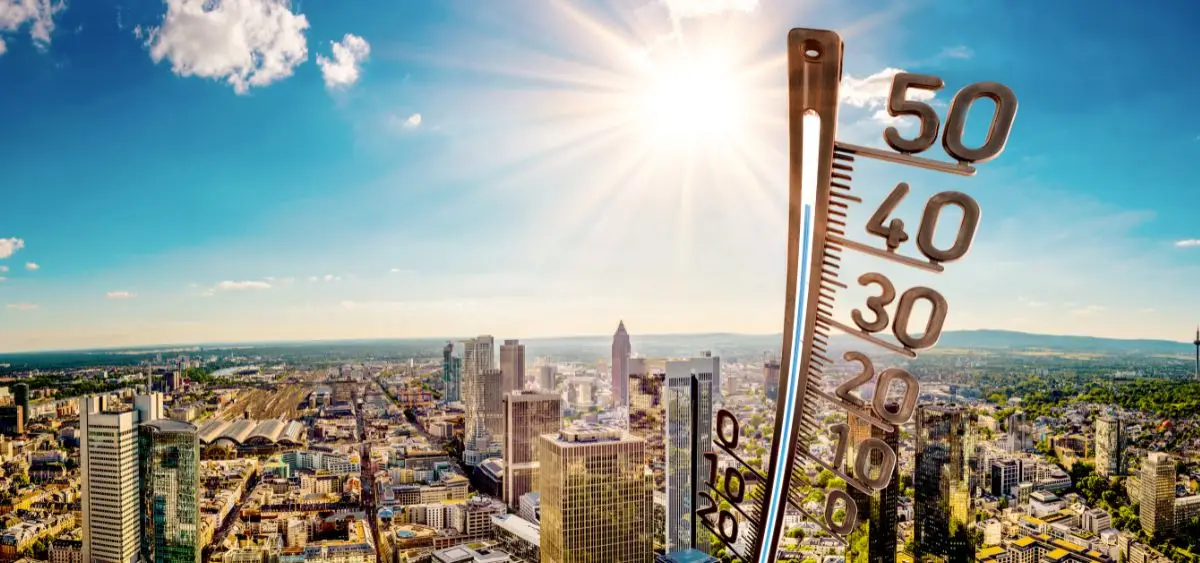Ever walked through a city on a summer afternoon and felt like you were roasting? That’s not just the sun—it’s something called the Urban Heat Island effect, and it’s making cities dangerously hotter than the areas around them. From rising electricity bills to serious health risks, UHI is a silent problem most people don’t even know exists. But here’s the good news: we can fix it—and you can be part of the solution.
Keep reading to find out what’s really heating up our cities, what it means for your health, and the smart, green strategies that can cool things down—starting today.
Also, read: Biomimicry in Action: Nature-Inspired Tech for a Sustainable Future
What Is an Urban Heat Island?
An Urban Heat Island (UHI) is when cities trap more heat than the countryside. This happens because roads, buildings, and pavements soak up the sun’s energy during the day and release it slowly at night. Trees and open land, which naturally keep places cool, are often missing in urban areas.
As a result, city temperatures can be several degrees hotter than surrounding rural regions—especially after sunset. This isn’t just uncomfortable—it can affect health, energy use, and even the environment.
Also, read: The Rise of the Circular Economy: How Tech is Reducing Waste
Factors Contributing to the Urban Heat Island (UHI) Effect
Several elements play a role in intensifying the UHI effect:
- Dark Surfaces: Urban materials such as asphalt and dark-colored rooftops absorb more solar energy due to their low reflectivity, leading to higher surface temperatures.
- Lack of Greenery: Vegetation like trees and shrubs helps cool the air through shade and evapotranspiration. In cities, the scarcity of such greenery limits this natural cooling process.
- Heat Emissions: Heat generated by vehicles, industrial operations, and HVAC systems adds to the ambient temperature in urban environments.
- Urban Layout: The design of cityscapes—with high-rise buildings and narrow streets—can trap heat and restrict air movement, worsening temperature build-up in these areas.
Also, read: Billionaire Gives Away $3 Billion Company to Save the Planet!

The Global Reach of Urban Heat Islands
Urban Heat Islands (UHIs) are more than just a local environmental concern—they contribute to challenges on a worldwide scale:
- Rising Energy Demand: Warmer urban climates drive up the use of air conditioning, placing greater strain on electricity grids.
- Worsening Air Quality: Increased energy consumption often results in more emissions, contributing to pollution and greenhouse gases buildup.
- Public Health Concerns: Persistent high temperatures can trigger heat-related illnesses and worsen chronic health issues.
- Disproportionate Effects on At-Risk Groups: Seniors, young children, and economically disadvantaged communities face heightened vulnerability to the dangers of excessive heat.
Also, read: Carbon Footprint: How You’re Unknowingly Hurting the Planet
Strategies for Mitigating Urban Heat Islands
To combat the UHI effect, several mitigation strategies can be implemented:
1. Cool Roof Technology: Applying reflective coatings or using light-colored roofing materials can reduce roof temperatures, decreasing indoor cooling needs.
2. Green Roof Solutions: Installing vegetation on rooftops provides insulation, reduces roof temperatures, and improves air quality.
3. Heat-Resistant Pavements: Using materials that reflect more sunlight and absorb less heat can lower surface temperatures.
4. Climate-Resilient Urban Planning: Designing cities with heat mitigation in mind, including the integration of green spaces and water bodies, can help manage urban temperatures.
5. Urban Heat Mapping: Identifying hotspots within cities allows for targeted interventions to reduce temperatures in the most affected areas.
6. Tree Canopy Coverage: Planting and maintaining trees provide shade and cooling through evapotranspiration, significantly reducing local temperatures.
7. Reflective Building Materials: Using materials with high reflectivity for building exteriors can minimize heat absorption.
8. Permeable Pavement Systems: These allow water to seep through, reducing surface temperatures and managing stormwater.
9. Heatwave Preparedness in Cities: Developing early warning systems and public awareness campaigns can help communities prepare for and respond to extreme heat events.
10. Sustainable Urban Infrastructure: Incorporating sustainability into urban development ensures long-term resilience against heat islands.
Also, read: What Is Sustainable Technology? Easy Examples and Why It Matters

Smart City Cooling Solutions
Innovative approaches are being adopted to cool urban areas:
- Urban Greening Initiatives: Programs focused on increasing green spaces within cities.
- Energy-Efficient Urban Design: Designing buildings and infrastructure to minimize energy use and heat generation.
- Urban Heat and Public Health: Integrating health considerations into urban planning to protect vulnerable populations.
- Urban Heat Island Monitoring Tools: Utilizing technology to monitor and analyze temperature variations across urban landscapes.
Conclusion
The Urban Heat Island effect is a pressing issue that exacerbates the challenges posed by climate change. By understanding its causes and implementing effective mitigation strategies, cities can become more livable and resilient. Collaborative efforts between governments, communities, and individuals are essential to cool our cities and protect public health.
Also, read: Zero Waste Challenge: Small Changes, Big Impact
FAQs
1. How much hotter can cities get due to UHI?
Cities can be 2°C to 10°C (about 4°F to 18°F) hotter than surrounding rural areas, especially at night.
2. Which cities are most affected by UHIs?
Large, densely populated cities like Delhi, Mumbai, New York, Tokyo, and Los Angeles often experience strong UHI effects due to heavy construction and fewer green areas.
3. What is cool roof technology?
It uses materials or coatings that reflect more sunlight and absorb less heat, helping to keep buildings and cities cooler.
4. Can green roofs really make a difference?
Absolutely. Green roofs provide insulation, absorb rainwater, and reduce surface temperatures, helping cities stay cooler.
5. Are there any tools to monitor Urban Heat Islands?
Yes, cities and scientists use satellite data, temperature sensors, and heat maps to monitor and manage UHIs effectively.










